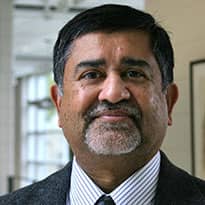Editors' Note: This article is part of the Public Square 2014 Summer Series: Conversations on Religious Trends. Read other perspectives from the Hindu community here.
India and the Indian sub-continent is civilizationally Hindu, by which we mean that the foundational philosophy and ways of life carved out and established anywhere from five to ten millennia ago or more were what we would now call Hindu: the Vedic scriptures, the yoga and meditation poses found on the seals at Mohenjo-daro, dating back to at least 2600 B.C.E., the two great epics—the Ramayana and the Mahabharata—and the life and times they capture, the language of the priests, Sanskrit, and the system of varnas and jatis, the "open source" system that Hinduism is, all can be termed Hindu (or any of its variants—Vedism, Sanatana Dharma, etc).
India, however, has also been the target of aggressive monotheistic religions founded over the past two millennia—Christianity and Islam—and the depredations these two religions have wrought all over the world, making the world majority Christian and Muslim. The attacks and invasions by Muslim marauders since the 8th century, with the more organized and deadly assaults since the 12th century, made the Indian sub-continent an Islamic citadel, leaving about 35 to 40 percent of its denizens Muslims at present (taking into account the population of Muslims in Pakistan and Bangladesh, as well as Afghanistan, which were all part of the ancient Hindu kingdoms and within the Hindu civilizational embrace). Christianity brought other changes, including the English language and the insidious comparisons between the Indian civilizational ethos and the European Christian supremacist views about the nature of the world and the Gods that governed human life.
When India gained independence in 1947, Mahatma Gandhi insisted that Jawaharlal Nehru—trained in Eton and Cambridge, and at ease drinking Scotch, smoking cigarettes, and flirting with women, speaking impeccable English, and garrulous and imperious at the same time—was better suited to dealing with world powers than the more liked and the more able leader, Sardar Vallabhbhai Patel, whom Nehru disliked and considered more provincial and more Hindu. From 1947 till two months ago, with some very short breaks in between, India has been influenced by Nehruvian ideas. Many of the Anglicized, English-speaking elites, as well as the "minority" Christians and Muslims, were comfortable with these ideas since Nehru was able to stand India on its Hindu civilization head, crowning "socialism, internationalism, and secularism" and "India as an idea" as India's modern and new destiny.
The travesty of this position can be seen in the wholesale marginalization if not programmatic demonization of Hindu ideas, which are grand, all-embracing, liberal, open, and truly celebratory of diversity. Hinduism and Hindus, pushed into a corner, relegated to second-class status in their "punya bhoomi" or "sacred land" (shorn of control over their temples and educational institutions, forced into accepting civil laws not applicable to Christians, Muslims, and other minorities, and sliced and diced by political parties based on the divisions of caste, region, language, and other identities) developed some responses that were not altogether healthy. With the English-speaking elites in control of the media and academe, the "secular socialists" in bed with the Soviets and the Chinese, the "minority" Muslims getting support from the Wahhabi Saudis pumping billions into building mosques and radicalizing Muslim youth, and the white evangelists in the U.S. and Europe pumping billions into "church planting" programs and insidious propaganda against Hinduism in their own home bases, India, as an open democracy, became the playground for anarchists, Muslim irredentists, and Christian fundamentalists all invited to sup at the high tables in Delhi to re-imagine and reinvent India. It was nothing but Hindu adaptability and sanguinity that have kept India from exploding into anarchic violence, as we have seen happen elsewhere, from Africa to the Middle East and beyond.
India has almost been made ungovernable, and the Indian treasury has been looted by Nehru's heirs and their henchmen over the past decades. Indian foreign policy is in shambles, with Indian diplomats mouthing old clichés in a multi-polar world. Indian economic policy is an exquisite mess of hunting with the corporate hounds and running with the multitude of poor, illiterate, deprived hares. Indian writers in English, celebrated and lured by million-dollar book deals, target Hindus and Hinduism in their oeuvres on the social and individual malaise afflicting the nation. When a rare Hindu takes offence and goes to court or a boorish political outfit goes on a mini rampage, the world's newspapers, led by the New York Times, publish bigoted reports and opinion pieces on Hindu culpability, and work hard to demonize a man like Narendra Modi, and label consistently the political party he belongs to as "controversial."





